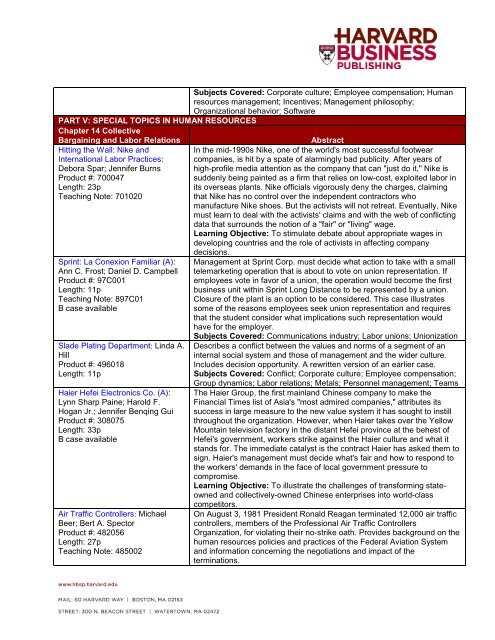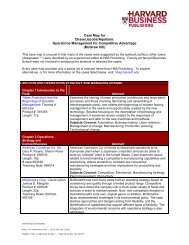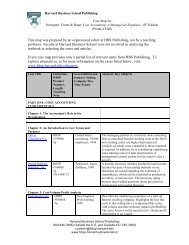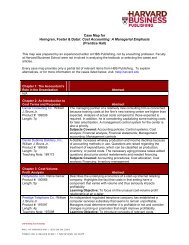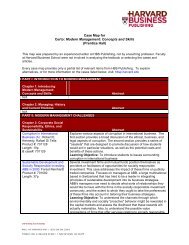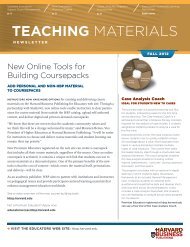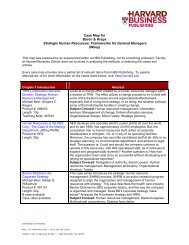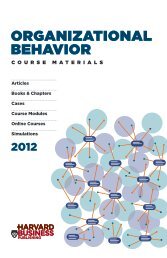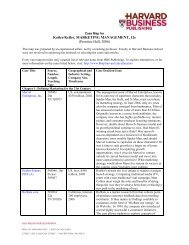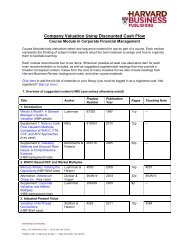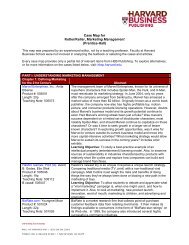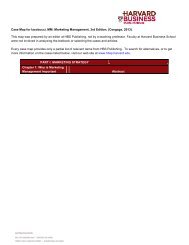Case Map for Noe, Hollenbeck, Gerhart & Wright - Harvard Business ...
Case Map for Noe, Hollenbeck, Gerhart & Wright - Harvard Business ...
Case Map for Noe, Hollenbeck, Gerhart & Wright - Harvard Business ...
Create successful ePaper yourself
Turn your PDF publications into a flip-book with our unique Google optimized e-Paper software.
Subjects Covered: Corporate culture; Employee compensation; Human<br />
resources management; Incentives; Management philosophy;<br />
Organizational behavior; Software<br />
PART V: SPECIAL TOPICS IN HUMAN RESOURCES<br />
Chapter 14 Collective<br />
Bargaining and Labor Relations<br />
Hitting the Wall: Nike and<br />
International Labor Practices:<br />
Debora Spar; Jennifer Burns<br />
Product #: 700047<br />
Length: 23p<br />
Teaching Note: 701020<br />
Sprint: La Conexion Familiar (A):<br />
Ann C. Frost; Daniel D. Campbell<br />
Product #: 97C001<br />
Length: 11p<br />
Teaching Note: 897C01<br />
B case available<br />
Slade Plating Department: Linda A.<br />
Hill<br />
Product #: 496018<br />
Length: 11p<br />
Haier Hefei Electronics Co. (A):<br />
Lynn Sharp Paine; Harold F.<br />
Hogan Jr.; Jennifer Benqing Gui<br />
Product #: 308075<br />
Length: 33p<br />
B case available<br />
Air Traffic Controllers: Michael<br />
Beer; Bert A. Spector<br />
Product #: 482056<br />
Length: 27p<br />
Teaching Note: 485002<br />
Abstract<br />
In the mid-1990s Nike, one of the world's most successful footwear<br />
companies, is hit by a spate of alarmingly bad publicity. After years of<br />
high-profile media attention as the company that can "just do it," Nike is<br />
suddenly being painted as a firm that relies on low-cost, exploited labor in<br />
its overseas plants. Nike officials vigorously deny the charges, claiming<br />
that Nike has no control over the independent contractors who<br />
manufacture Nike shoes. But the activists will not retreat. Eventually, Nike<br />
must learn to deal with the activists' claims and with the web of conflicting<br />
data that surrounds the notion of a "fair" or "living" wage.<br />
Learning Objective: To stimulate debate about appropriate wages in<br />
developing countries and the role of activists in affecting company<br />
decisions.<br />
Management at Sprint Corp. must decide what action to take with a small<br />
telemarketing operation that is about to vote on union representation. If<br />
employees vote in favor of a union, the operation would become the first<br />
business unit within Sprint Long Distance to be represented by a union.<br />
Closure of the plant is an option to be considered. This case illustrates<br />
some of the reasons employees seek union representation and requires<br />
that the student consider what implications such representation would<br />
have <strong>for</strong> the employer.<br />
Subjects Covered: Communications industry; Labor unions; Unionization<br />
Describes a conflict between the values and norms of a segment of an<br />
internal social system and those of management and the wider culture.<br />
Includes decision opportunity. A rewritten version of an earlier case.<br />
Subjects Covered: Conflict; Corporate culture; Employee compensation;<br />
Group dynamics; Labor relations; Metals; Personnel management; Teams<br />
The Haier Group, the first mainland Chinese company to make the<br />
Financial Times list of Asia's "most admired companies," attributes its<br />
success in large measure to the new value system it has sought to instill<br />
throughout the organization. However, when Haier takes over the Yellow<br />
Mountain television factory in the distant Hefei province at the behest of<br />
Hefei's government, workers strike against the Haier culture and what it<br />
stands <strong>for</strong>. The immediate catalyst is the contract Haier has asked them to<br />
sign. Haier's management must decide what's fair and how to respond to<br />
the workers' demands in the face of local government pressure to<br />
compromise.<br />
Learning Objective: To illustrate the challenges of trans<strong>for</strong>ming stateowned<br />
and collectively-owned Chinese enterprises into world-class<br />
competitors.<br />
On August 3, 1981 President Ronald Reagan terminated 12,000 air traffic<br />
controllers, members of the Professional Air Traffic Controllers<br />
Organization, <strong>for</strong> violating their no-strike oath. Provides background on the<br />
human resources policies and practices of the Federal Aviation System<br />
and in<strong>for</strong>mation concerning the negotiations and impact of the<br />
terminations.


